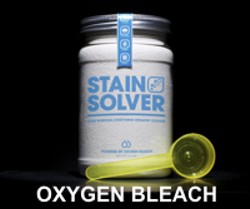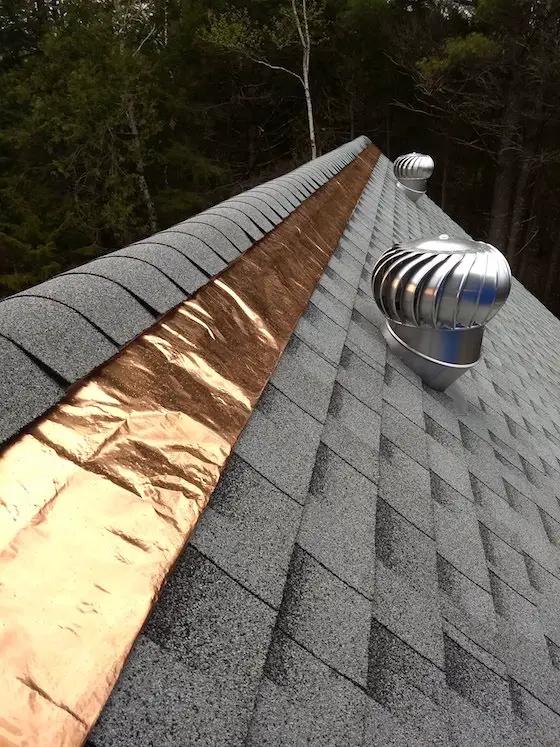How To Remove Roof Algae

Clean roof shingles with Stain Solver. This roof is covered with different species of roof algae. You can see where the lead is helping to keep the roof clean. If there was a copper strip along the entire roof ridge, the roof would be perfectly clean. CLICK on THE IMAGE to purchase the copper strips and solid copper nails.
How To Remove Roof Algae
DEAR TIM: Many of the roofs in my neighborhood are covered with black streaks, mine included. What's causing this to happen and can the roofs be cleaned? I'm able to walk on my asphalt shingle roof with ease, but am afraid of hurting the shingles by cleaning them.
Once the roof is clean, is there a way to prevent the streaking from returning? Could all of this been prevented? Molly G., Jacksonville, FL
DEAR MOLLY: Hundreds of thousands of roofs on homes and other buildings suffer from the stains you're plagued with. It's a harmless algae that's gorging itself on the powdered limestone filler that's often added to the liquid asphalt in shingles to help add weight to them.
This limestone never used to be a component of shingles. When the matts used to build shingles switched from traditional felt paper to fiberglass, the manufacturers had a problem getting the shingles up to the minimum weight requirement. Someone decided to use powdered limestone dust, but they didn't realize that it was a delectable food for the tiny algae. Fortunately, the algae doesn't harm the shingles.
The first thing to do is to be sure to read any paperwork that you might have concerning the warranty for your shingles. You want to discover how the manufacturer recommends to clean their product. If you don't have it, you can frequently get it easily online at the shingle manufacturer's website.
To save you the trouble, most manufacturers will void the warranty of their shingles if they discover you used a pressure washer on your roof. They're afraid that if an untrained person gets the cleaning wand too close to the surface, it will blast away the ceramic granules that provide protection to the tender shingle below.
A few years ago I decided to test a pressure washer on asphalt shingles to see what would happen. I did this on my own home on an asphalt shingle roof that had a 15-year warranty and the shingles had been on the roof for 22 years! I was getting ready to install a new roof, so if I did damage the shingles it wouldn't matter.
I used a 25-degree tip on the 2,400 psi pressure washer and held the wand about 9 inches away from the surface always pointing the wand down the roof. The water spray cleaned off all the lichens, moss and algae leaving the roof looking like it was new. I constantly stopped to check to see if I was removing any of the colored ceramic granules. In my case, the shingles were not damaged.
I do NOT recommend you do this, as you may damage your shingles. I just wanted to share the results of my experiment. You should never do anything that would void a warranty.
Instead you should clean your roof with just regular soap and water and a scrub brush. I've gotten stellar results using an oxygen bleach solution. Some people use chlorine bleach and water, but chlorine bleach is highly toxic to any vegetation that surrounds your home. Any chlorine solution that drips or is rinsed off the roof can kill your landscaping. Oxygen bleach does not harm vegetation.
 It's best to clean a roof when it's cool and the sky is overcast. Working on a sunny day will cause the cleaning solution to evaporate in seconds or a few minutes. Spray the oxygen bleach solution on the roof working in strips from top to bottom of the roof. Each strip you clean should only be 4 feet wide. You do NOT want to be standing on a wet part of the roof as you clean. Always be on a dry section as the cleaning solution is slippery. Consider wearing a fall-protection harness in case something goes wrong.
It's best to clean a roof when it's cool and the sky is overcast. Working on a sunny day will cause the cleaning solution to evaporate in seconds or a few minutes. Spray the oxygen bleach solution on the roof working in strips from top to bottom of the roof. Each strip you clean should only be 4 feet wide. You do NOT want to be standing on a wet part of the roof as you clean. Always be on a dry section as the cleaning solution is slippery. Consider wearing a fall-protection harness in case something goes wrong.
Once the roof is clean, you can prevent the algae from coming back by installing a strip of copper at the top of the roof. This photo shows exactly how the copper should look:

I was the first person in the world to identify that copper prevents the oxidation of asphalt molecules on asphalt shingles. It also stops roof algae and moss. See how easy it is to install this copper in a new-roof installation? CLICK the photo to order the copper strips.
If you have about 3 inches of copper exposed at the top of the roof, each time it rains a tiny amount of copper will wash down on the roof. Copper is a natural biocide and the algae will not grow in its presence. Zinc works too as does lead, but the copper is more powerful.
You can purchase asphalt shingles that contain copper in the ceramic granules. These shingles are marketed as being algae resistant. I tried these on a shed I built and was disappointed. The north-facing section of the roof developed black algae stains in just three years.
It's my feeling the roofing manufacturer didn't put enough of the copper-containing granules in the shingles as a cost-saving measure. Copper is getting very expensive and to stay competitive, the manufacturer possibly decided to put less in the shingle.
Look for algae resistant shingles that have the best warranty. These probably have enough copper in them to resist algae growth.
You can watch a video that shows how to clean roof algae. Simply type "removing algae stains video" into the search engine at www.AsktheBuilder.com.
Column 955
2 Responses to How To Remove Roof Algae